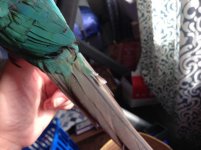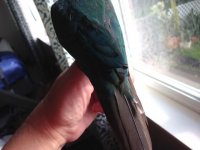ManuIki
New member
- Oct 15, 2015
- 18
- 11
- Parrots
- Pepe is a turquoise green-cheeked conure, born May 22, 2015. We (husband and I) also call him "Manu Iki" (Hawaiian for "Little Bird").
I'm fairly new to the conure world, and I am *loving* it. Pépe is a constant delight, and my husband and I are in love. I've been mainly lurking and absorbing information from all of you. This forum is really helpful, and so fun to read and see the photos of your little buddies!
We've had Pépe for a few weeks now. A couple of days ago, I noticed a small white feather (or a tightly clumped bundle of feathers) sticking out of his lower back/base of tail area. It looked like a tight group of white feathers that had been chopped off, if you can imagine that. Like if you took several white feathers, held them together, and cut off the ends.
It wasn't sticking way out, only about a half-inch from the other feathers, but today it's moved downward, and now it looks more like a piece of something wrapped around the base of one feather. The tight grouping of white feather seems to have grown longer and spread out.
I'm probably not describing this very well. Here are photos. Is this just tail gunk working its way down the feather shaft and off his body? Pépe doesn't seem concerned about it, and he doesn't seem to want me to pick it off. On the other hand, it doesn't bother him if I poke around back there.
Thank you for any help or insight.
We've had Pépe for a few weeks now. A couple of days ago, I noticed a small white feather (or a tightly clumped bundle of feathers) sticking out of his lower back/base of tail area. It looked like a tight group of white feathers that had been chopped off, if you can imagine that. Like if you took several white feathers, held them together, and cut off the ends.
It wasn't sticking way out, only about a half-inch from the other feathers, but today it's moved downward, and now it looks more like a piece of something wrapped around the base of one feather. The tight grouping of white feather seems to have grown longer and spread out.
I'm probably not describing this very well. Here are photos. Is this just tail gunk working its way down the feather shaft and off his body? Pépe doesn't seem concerned about it, and he doesn't seem to want me to pick it off. On the other hand, it doesn't bother him if I poke around back there.
Thank you for any help or insight.

